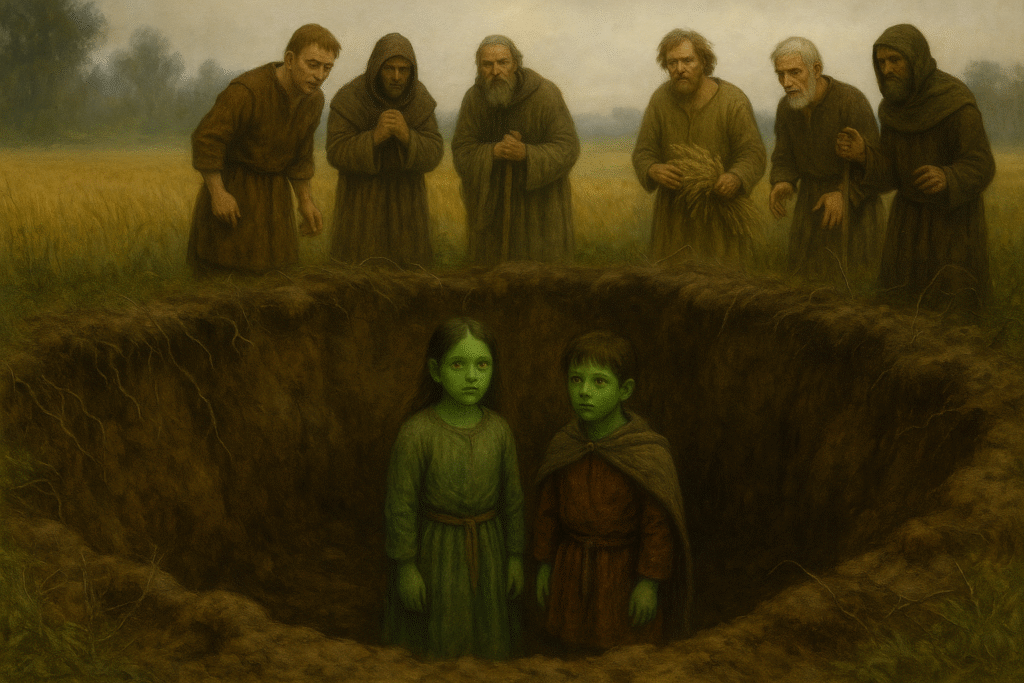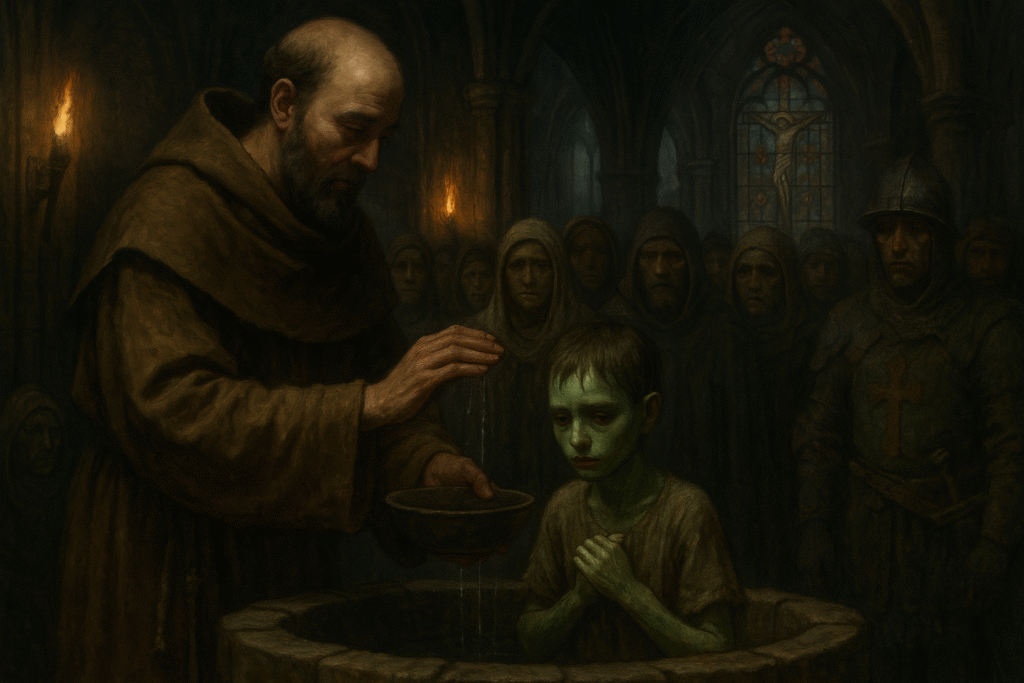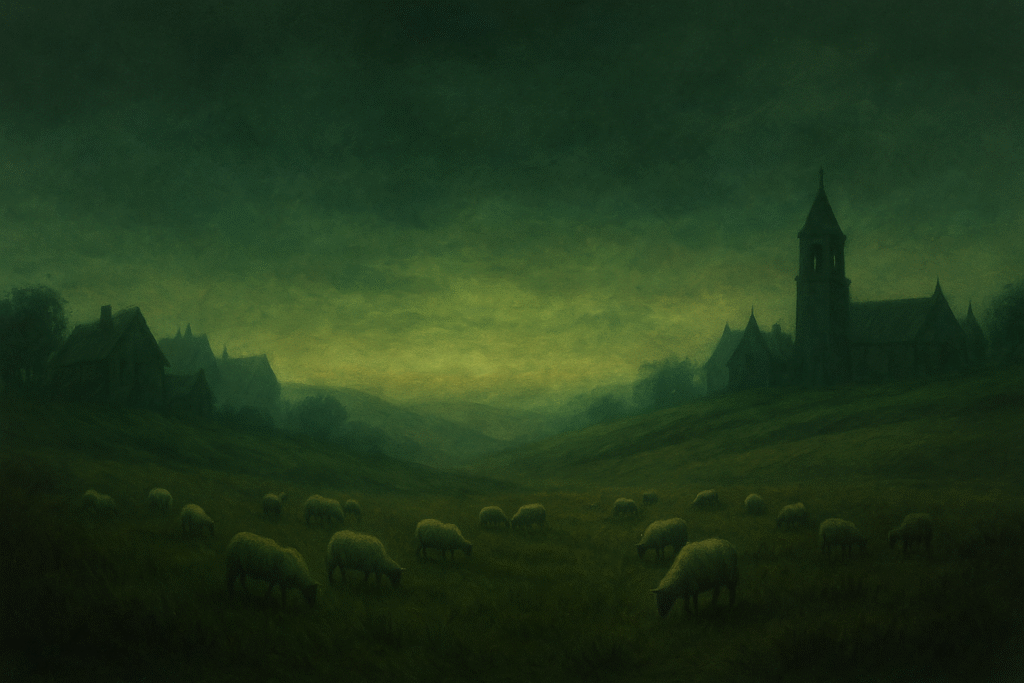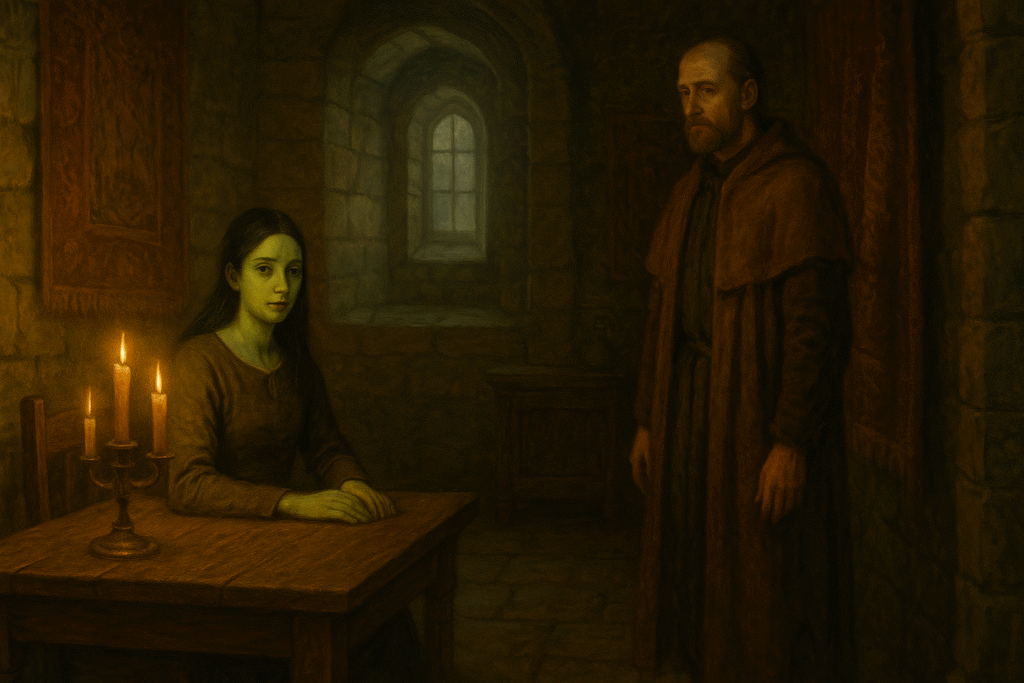England in the 12th century was known for its strange happenings. It was a time of legends and superstition, a fertile ground for tales of creatures and odd occurrences. None, however, are more peculiar than the legend of the Green Children, documented in a small Suffolk village called Woolpit.
Woolpit took its name from the “wolf pits” once used to trap the predators that roamed the countryside. According to surviving accounts, it was near one of these very pits that local farmers, working in the fields during harvest, came across something truly strange—two children, a boy and a girl, who had fallen into one of the pits. They were calling out in an unfamiliar language and didn’t seem to understand English.
But what truly shocked the villagers was the colour of their skin:
It was green.

The Green Children From Nowhere
Two medieval chroniclers—William of Newburgh and Ralph of Coggeshall—recorded the strange occurrence, and their writings have preserved the tale to this day. According to their accounts, the children were wearing unusual clothing and spoke no known language. Their skin had a distinct green tint, and they appeared anxious, refusing any food offered to them by the villagers. They rejected bread and other staple items and began to starve.
It wasn’t until they came across raw green beans that they began to eat eagerly. The beans sustained them for a time, and gradually they were able to transition to a more varied diet. As their health improved, so too did their complexion—their skin faded from green to a more natural tone.
What Happened to the Children?
A wealthy landowner named Sir Richard de Calne took pity on the siblings and welcomed them into his home. Sadly, the boy—who was younger—grew weaker and eventually died, likely from the effects of malnutrition and trauma. He was baptized shortly before his death, as was customary when death seemed imminent.

But the girl survived. Over time, she learned to speak English and began to share her extraordinary story.
A Twilight World
When Sir Richard questioned her, the girl explained that she and her brother came from a distant land called “The Land of Saint Martin.” She described it as a dark place, saying:
“The sun does not rise upon our countrymen; our land is little cheered by its beams.”
She said that everything there—even the sky—had a greenish hue, and that all the people had green skin like hers and her brother’s.

She recounted how, while tending their father’s sheep, she and her brother heard the sound of beautiful bells. Enchanted, they followed the sound into a cavern. They walked for what felt like a long time in darkness, until they emerged into a land of dazzling sunlight. Disoriented and frightened, they stumbled into one of the wolf pits near Woolpit.
The girl later said the bell sounds reminded her of the bells from the Abbey of St. Edmund’s, likely referring to the one in nearby Bury St. Edmunds. But she couldn’t explain the transition. One moment, they were listening to bells; the next, they were blinking and terrified in the blinding sunlight of Suffolk.
Agnes of Woolpit
The girl became fully assimilated into English life. She was baptized and given the name Agnes, and she grew up serving in Sir Richard’s household. According to Ralph of Coggeshall, she was known for having a “wanton and impudent” temperament, which reportedly caused tension in the pious home.

Agnes later moved to the King’s Lynn area, and one record suggests that she may have married a man named Richard Barre, who was Archdeacon of Ely. There were even rumors that she had a child of her own—raising the possibility that the so-called “green blood” may have entered English lineage. After that, Agnes disappeared from the historical record, fading into obscurity.
Seeking a Logical Explanation
The story is undeniably strange—and it’s no wonder that it captured the imagination of so many. Though most of the written records were documented after the fact, the tale was retold for centuries, each generation interpreting it through its own lens.
If we examine the legend critically and scientifically, a more plausible theory begins to emerge.
During the 12th century, Flemish settlers were moving into eastern England, including areas around Woolpit. A nearby settlement called Fornham St. Martin was home to many Flemish families. It’s entirely possible that the two children were from such a community.
In 1173, during a rebellion against King Henry II, a battle took place near Bury St. Edmunds involving Flemish mercenaries. After the battle, there were violent reprisals against Flemish communities. Some historians suggest the children were orphans of this conflict, their parents likely killed. Alone, malnourished, and speaking a language unfamiliar to the locals, the children would have appeared as something entirely foreign to the villagers of Woolpit.
What About Their Green Skin?
This remains the most mysterious detail—but even here, there may be a rational explanation.
The children were clearly malnourished, and some historians believe they suffered from hypochromic anemia, historically known as “green sickness” or chlorosis. This condition, caused by severe iron deficiency, can result in a pale greenish tinge to the skin. It was especially common among children and young women in the Middle Ages.
While most cases only caused a slight discoloration, it’s plausible that in these extreme conditions—especially given the boy’s death—their symptoms were much more severe. Notably, the girl’s green skin faded as her health improved, supporting this theory.
Skeptics point out that Sir Richard was a well-traveled knight and would likely have recognized Flemish speech. However, the children may have been too young or traumatized to speak coherently, or they may have spoken a dialect unfamiliar to him.
Other Theories and Lingering Questions
Some point to the children only recognizing green beans as evidence of their otherworldliness. But this has no biological basis—unlike orange foods causing a slight orange tint to skin (as in carotenemia), green beans contain no pigment capable of turning skin green.
Others question the girl’s recounting of her origin. It’s important to remember that she may have been led in her answers. Modern psychology warns against relying on children as witnesses—especially in stressful situations, or when guided by adult questioning. Add the language barrier, and it’s easy to see how details could become distorted or embellished.
Enduring Fascination
Regardless of whether you believe they were Flemish children, fairy folk, aliens, or travelers from a twilight world, the story of Agnes and her brother continues to captivate people to this day.
From Victorian retellings full of fairy imagery to modern pop culture references, the Green Children of Woolpit live on. And it’s remarkable to think: it’s been over 850 years since that fateful day, when two green-skinned children emerged from a pit in Suffolk—and walked straight into legend.
As the bells ring out from Bury St. Edmunds, one can only wonder…
What other strange visitors might be drawn to our world by their mysterious call?
Sources & Further Reading
- William of Newburgh (1190s) & Ralph of Coggeshall (c. 1220), original accounts of the Green Children. en.wikipedia.orgen.wikipedia.org
- Charles Christian, Urban Fantasist – “The Green Children of Woolpit” (Medium, 2019). urbanfantasist.medium.comurbanfantasist.medium.com
- Ben Johnson, “The Green Children of Woolpit” – Historic UK (2021). historic-uk.comhistoric-uk.com
- “Green children of Woolpit.” en.wikipedia.orgen.wikipedia.org (for historical context and modern interpretations)
- Timothy R. Jones, “Who Were the Green Children of Woolpit?” – Medievalists.net (2025) medievalists.netmedievalists.net
